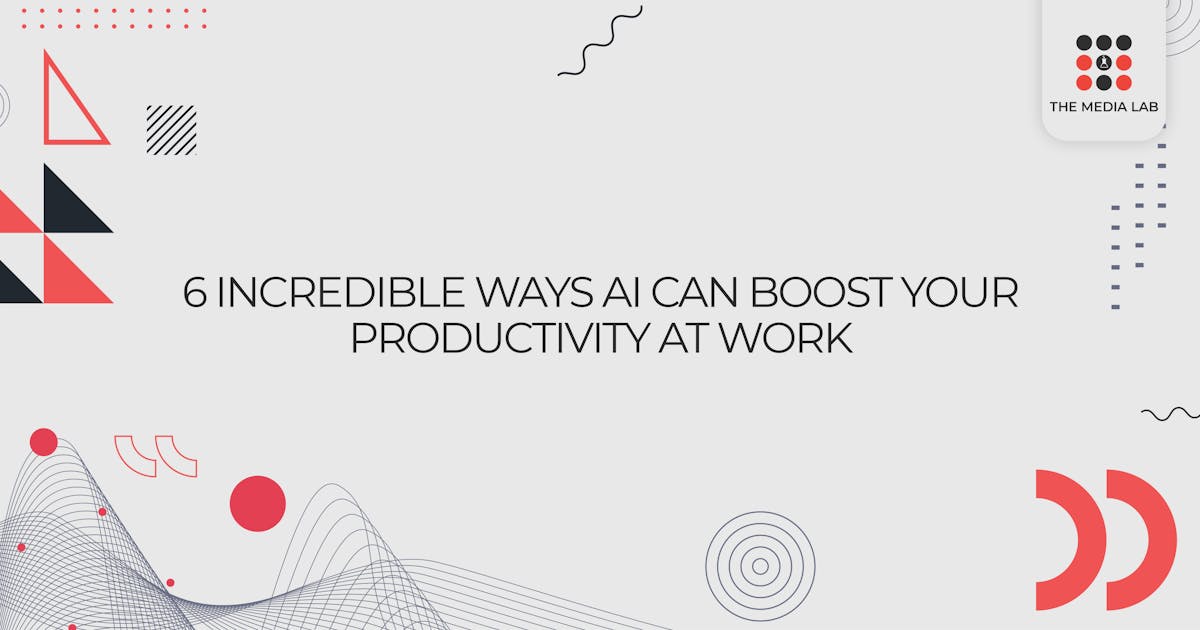In today's fast-paced business landscape, maximizing productivity is essential for staying competitive and achieving success. Fortunately, advancements in artificial intelligence (AI) have revolutionized the way we work, offering powerful tools and solutions to streamline processes, automate tasks, and unlock new levels of efficiency. From optimizing workflows to enhancing decision-making, AI has the potential to transform productivity in the workplace. In this comprehensive guide, we'll explore six incredible ways AI can boost your productivity at work, empowering you to achieve more in less time.

1. Intelligent Task Automation
One of the most impactful ways AI enhances productivity at work is through intelligent task automation. AI-powered tools and software can automate repetitive and time-consuming tasks, allowing employees to focus on high-value activities that require human expertise. Whether it's scheduling meetings, processing invoices, or responding to routine inquiries, AI-driven automation reduces manual effort, minimizes errors, and accelerates workflow efficiency.
For example, AI-powered virtual assistants like Siri or Google Assistant can handle administrative tasks such as setting reminders, sending emails, and managing calendars, freeing up valuable time for employees to focus on strategic priorities. Similarly, robotic process automation (RPA) software can automate data entry, document processing, and other repetitive tasks, significantly reducing processing times and increasing throughput.
2. Personalized Productivity Tools
AI enables the development of personalized productivity tools tailored to individual work styles and preferences. By analyzing user behavior, preferences, and performance patterns, AI algorithms can recommend personalized workflows, shortcuts, and productivity hacks to optimize efficiency. Whether it's organizing emails, prioritizing tasks, or managing time effectively, AI-powered productivity tools adapt to users' unique needs, enhancing their productivity and effectiveness at work. Even it's about creating professional videos with AI, it does all.
For example, email management platforms like Gmail use AI to categorize and prioritize incoming emails, automatically sorting them into relevant folders or suggesting actions based on user behavior. Similarly, project management tools like Asana or Trello leverage AI to recommend task priorities, deadlines, and resource allocations, helping teams stay organized and focused on critical objectives.
3. Enhanced Decision Support
AI empowers decision-makers with actionable insights and data-driven recommendations, enabling faster and more informed decision-making. Through advanced analytics, machine learning, and predictive modeling, AI algorithms analyze vast amounts of data to identify trends, patterns, and correlations that may not be apparent to human analysts. This enables organizations to make strategic decisions based on real-time data and accurate forecasts, reducing uncertainty and improving outcomes.
For example, AI-powered business intelligence platforms like Tableau or Power BI can analyze sales data, customer feedback, and market trends to identify emerging opportunities or potential risks. Similarly, AI-driven predictive analytics tools can forecast demand, optimize inventory levels, and anticipate customer preferences, helping businesses make data-driven decisions that drive growth and profitability.
4. Streamlined Communication and Collaboration
AI facilitates seamless communication and collaboration among teams, regardless of their location or time zone. AI-powered chatbots and virtual assistants enable real-time communication, information sharing, and collaboration, enhancing teamwork and productivity. Whether it's coordinating project tasks, conducting virtual meetings, or providing instant support, AI-driven communication tools streamline collaboration and foster a culture of innovation and agility.
For example, collaboration platforms like Microsoft Teams or Slack use AI to facilitate real-time messaging, file sharing, and project management, enabling teams to collaborate effectively and stay connected. Similarly, AI-driven virtual meeting assistants like Zoom's "Smart Meetings" feature can automate meeting scheduling, note-taking, and action item tracking, improving meeting productivity and efficiency.
5. Continuous Learning and Skill Development
AI-powered learning platforms enable continuous learning and skill development, empowering employees to acquire new knowledge and capabilities at their own pace. Through personalized learning paths, adaptive assessments, and interactive content, AI algorithms tailor learning experiences to individual needs and preferences, maximizing engagement and knowledge retention. Whether it's upskilling for new roles, mastering emerging technologies, or enhancing soft skills, AI-driven learning platforms facilitate lifelong learning and professional development.
For example, AI-powered learning management systems (LMS) like Coursera or Udemy leverage machine learning algorithms to recommend courses, track progress, and provide personalized feedback to learners. Similarly, AI-driven language learning apps like Duolingo or Babbel use natural language processing (NLP) to personalize lessons and adapt to users' proficiency levels, accelerating language acquisition and fluency.
6. Proactive Workforce Management
AI enables proactive workforce management by predicting staffing needs, optimizing resource allocation, and identifying potential bottlenecks or performance issues before they arise. Through predictive analytics and workforce optimization algorithms, AI systems forecast demand, analyze workforce trends, and recommend staffing strategies to optimize productivity and efficiency. Whether it's scheduling shifts, balancing workloads, or mitigating risks, AI-driven workforce management tools empower organizations to maximize the productivity of their workforce.
For example, AI-powered workforce management platforms like Workday or Kronos use predictive analytics to forecast staffing needs based on historical data, seasonal trends, and business objectives. Similarly, AI-driven employee scheduling software can automate shift planning, allocate resources efficiently, and ensure adequate coverage to meet operational demands.
Unlocking the Power of AI for Enhanced Productivity
In conclusion, AI offers unparalleled opportunities to boost productivity in the workplace, revolutionizing how we work, collaborate, and innovate. From intelligent task automation and personalized productivity tools to enhanced decision support and proactive workforce management,

